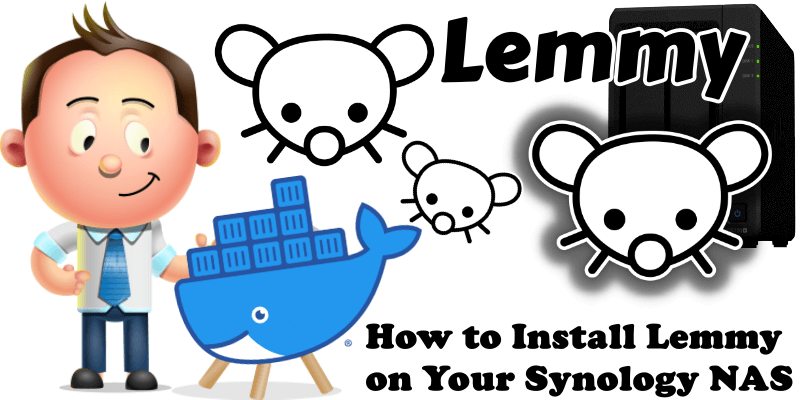
Lemmy is a selfhosted social link aggregation and discussion platform. It is completely free and open, and not controlled by any company. This means that there is no advertising, tracking, or secret algorithms. Content is organized into communities, so it is easy to subscribe to topics that you are interested in, and ignore others. Voting is used to bring the most interesting items to the top. There are strong moderation tools to keep out spam and trolls. A Lemmy website can operate alone. Just like a traditional website, people sign up on it, post messages, upload pictures and talk to each other. Unlike a traditional website, Lemmy instances can interoperate, letting their users communicate with each other. In this step by step guide I will show you how to install Lemmy on your Synology NAS using Docker & Portainer.
STEP 1
Please Support My work by Making a Donation.
STEP 2
Install Portainer using my step by step guide. If you already have Portainer installed on your Synology NAS, skip this STEP. Attention: Make sure you have installed the latest Portainer version.
STEP 3
Make sure you have a synology.me Wildcard Certificate. Follow my guide to get a Wildcard Certificate. If you already have a synology.me Wildcard certificate, skip this STEP.
STEP 4
Go to Control Panel / Network / Connectivity tab/ Check Enable HTTP/2 then click Apply. Follow the instructions in the image below.

STEP 5
Go to Control Panel / Security / Advanced tab/ Check Enable HTTP Compression then click Apply. Follow the instructions in the image below.
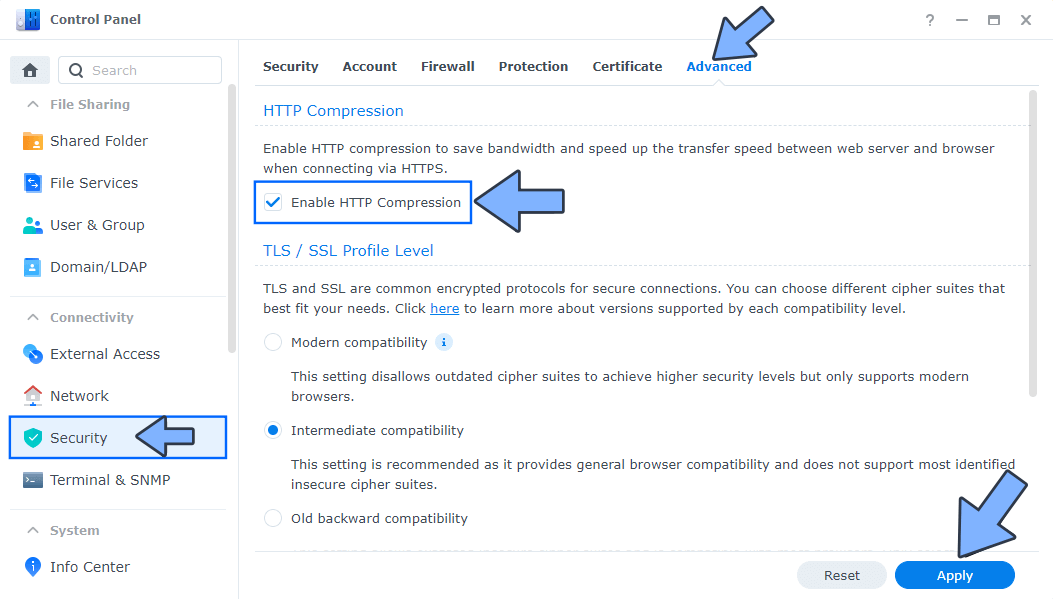
STEP 6
Go to Control Panel / Login Portal / Advanced Tab / click Reverse Proxy. Follow the instructions in the image below.
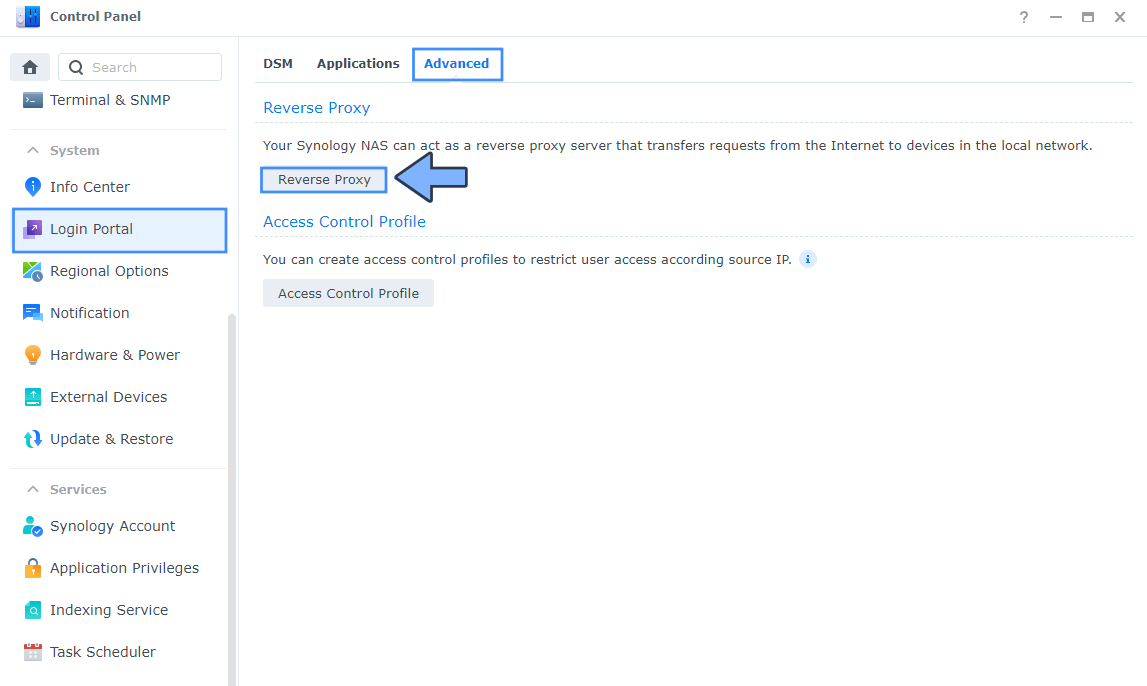
STEP 7
Now click the “Create” button. Follow the instructions in the image below.
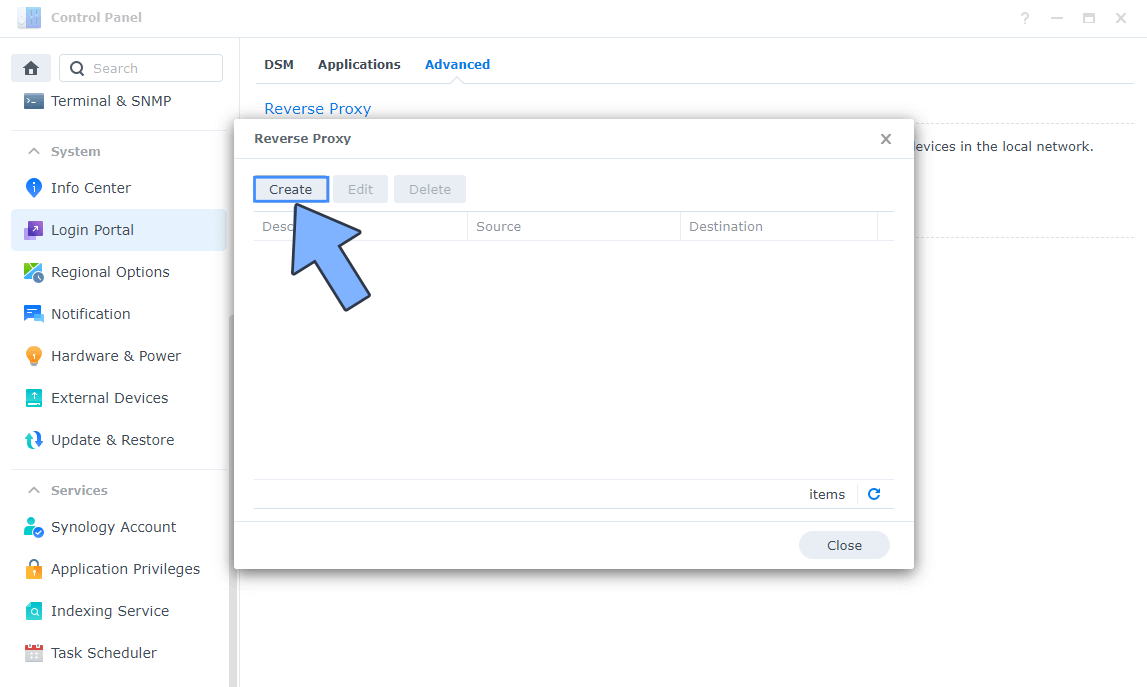
STEP 8
After you click the Create button, the window below will open. Follow the instructions in the image below.
On the General area, set the Reverse Proxy Name description: type in Lemmy BACK. After that, add the following instructions:
Source:
Protocol: HTTPS
Hostname: lemmyback.yourname.synology.me
Port: 443
Check Enable HSTS
Destination:
Protocol: HTTP
Hostname: localhost
Port: 8536

STEP 9
On the Reverse Proxy Rules click the Custom Header tab. Click Create and then, from the drop-down menu, click WebSocket. After you click on WebSocket, two Header Names and two Values will be automatically added. Click Save. Follow the instructions in the image below.

STEP 10
Go to Control Panel / Login Portal / Advanced Tab / click Reverse Proxy. Follow the instructions in the image below.
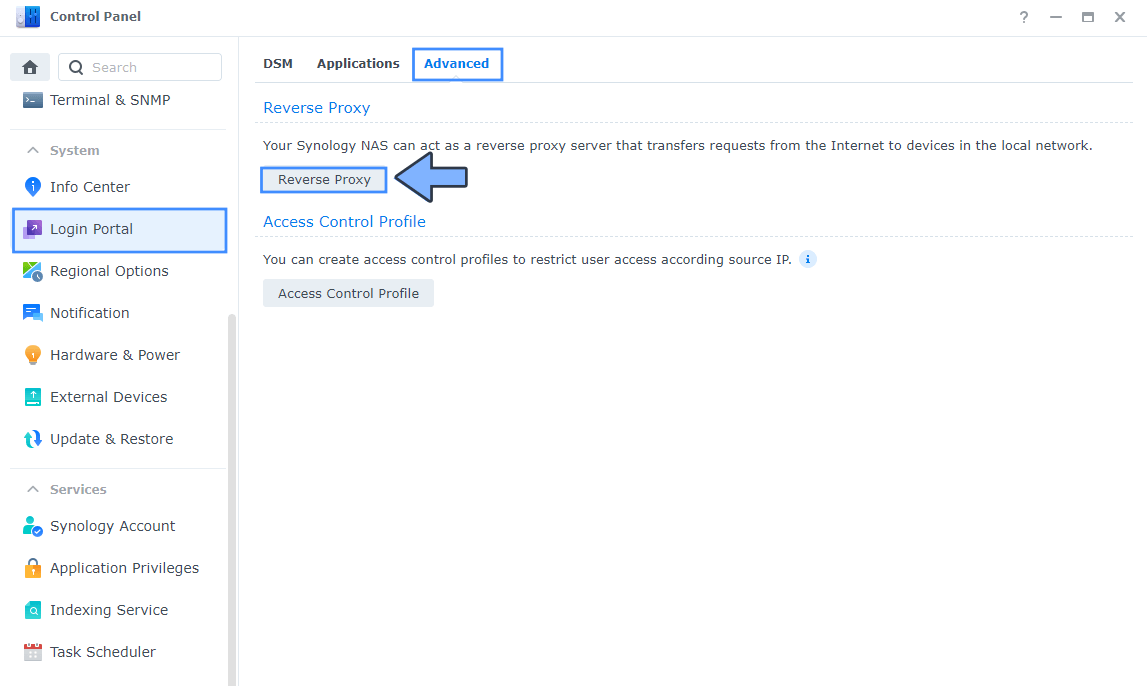
STEP 11
Now click the “Create” button. Follow the instructions in the image below.
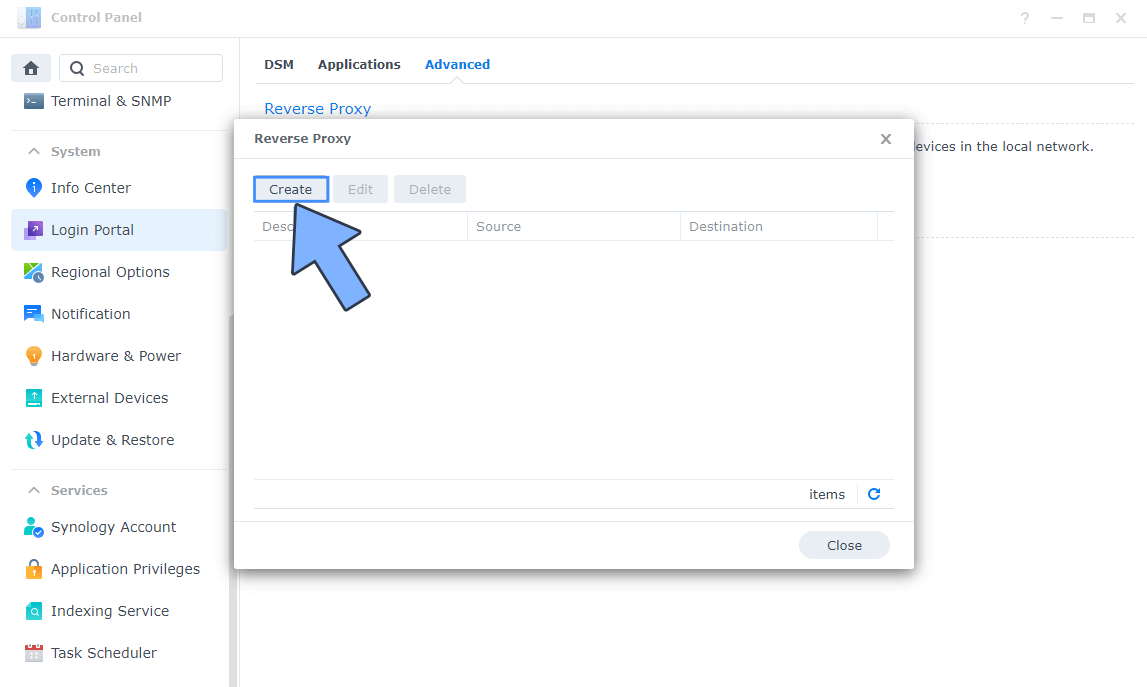
STEP 12
After you click the Create button, the window below will open. Follow the instructions in the image below.
On the General area, set the Reverse Proxy Name description: type in Lemmy FRONT. After that, add the following instructions:
Source:
Protocol: HTTPS
Hostname: lemmy.yourname.synology.me
Port: 443
Check Enable HSTS
Destination:
Protocol: HTTP
Hostname: localhost
Port: 1236
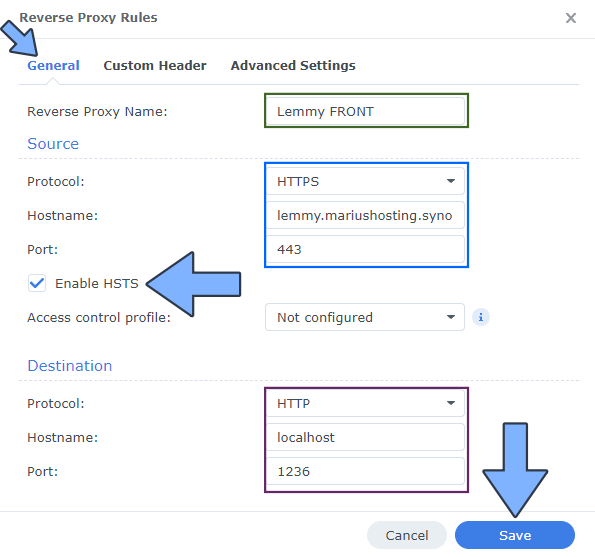
STEP 13
On the Reverse Proxy Rules click the Custom Header tab. Click Create and then, from the drop-down menu, click WebSocket. After you click on WebSocket, two Header Names and two Values will be automatically added. Click Save. Follow the instructions in the image below.

STEP 14
Go to File Station and open the docker folder. Inside the docker folder, create one new folder and name it lemmy. Follow the instructions in the image below.
Note: Be careful to enter only lowercase, not uppercase letters.
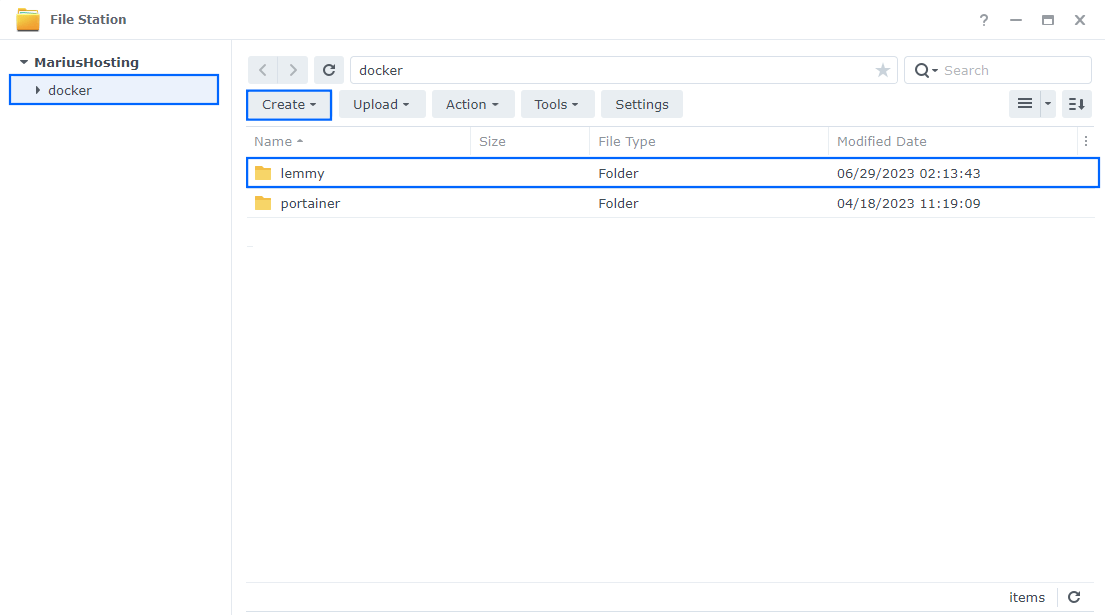
STEP 15
Now create two new folders inside the lemmy folder that you created at STEP 14 and name them db and pictrs. Follow the instructions in the image below.
Note: Be careful to enter only lowercase, not uppercase letters.
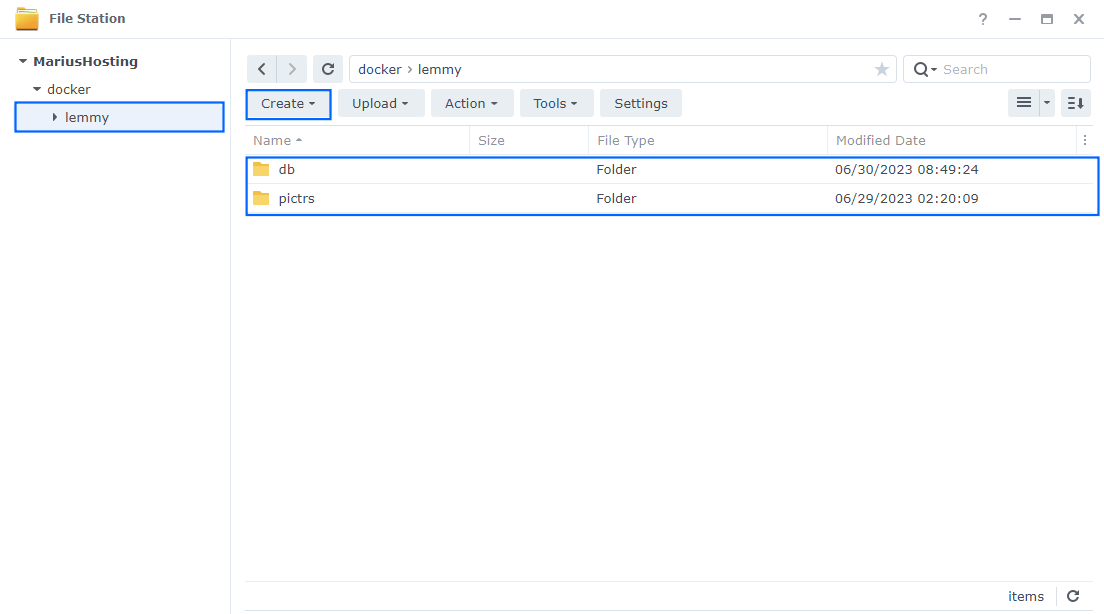
STEP 16
Download (click on the blue link below) then upload the nginx.conf file below in the lemmy folder that you have previously created at STEP 14. Follow the instructions in the image below. 🔒Note: Support my work to unlock the password. You can use this password to download any file on mariushosting forever!
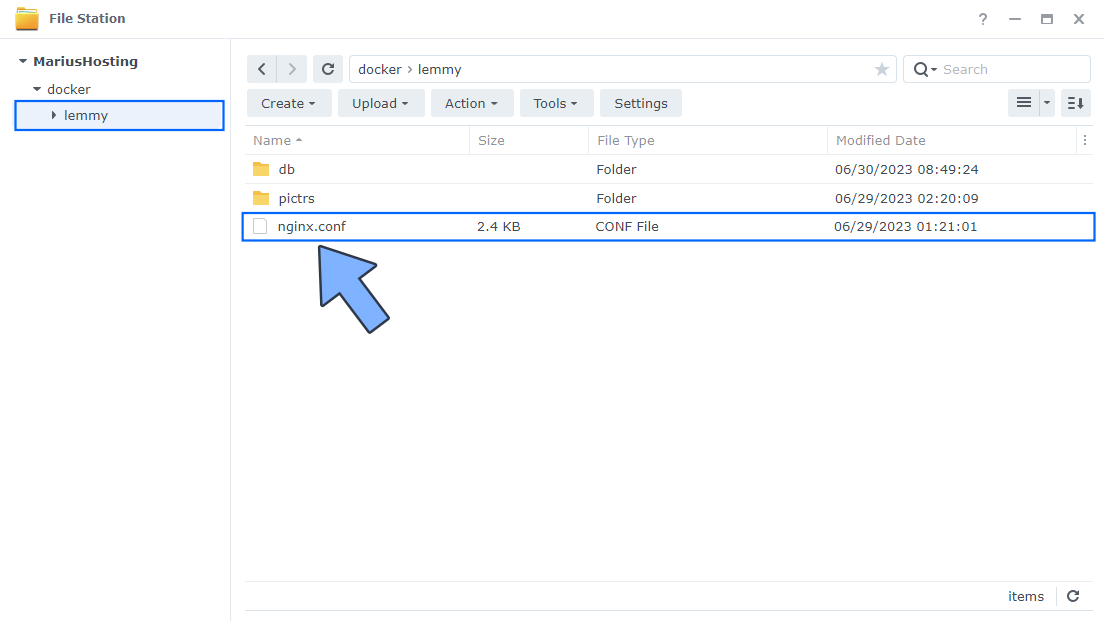
STEP 17
Follow my step by step guide on how to activate SMTP for your Gmail account. This step is mandatory. Note: If you don’t want to use the easiest way for SMTP with Google and you already have SMTP details from your own Mail Server, you can just skip this STEP and use your personalized email SMTP details instead.
STEP 18
Download the config.hjson file by clicking the blue link below. Using notepad or something similar on your computer, change the SMTP lines, LEMMY ADMIN lines and DDNS line. After you add your own parameters as per the example below, save the file. Follow the instructions in the image below. 🔒Note: Support my work to unlock the password. You can use this password to download any file on mariushosting forever!
⚠️Warning: Do not change any of the other values. All the values should be inside ” “.
SMTP
smtp_login: “YourOwnGmailAddress” STEP 17.
smtp_passowrd: “YourOwnGmailAPPassword” STEP 17.
smtp_from_address: “YourOwnGmailAddress” STEP 17.
⚠️Warning: Do not change any of the other values. All the values should be inside ” “.
LEMMY ADMIN
admin_username: “yourowname”
admin_password: “yourownpassword”
site_name: “yourfavoritesitename”
admin_email: “yourownemail”
⚠️Warning: Do not change any of the other values. All the values should be inside ” “.
Synology DDNS
hostname: “lemmy.yourname.synology.me” STEP 12.

STEP 19
Now upload the config.hjson file with your own parameters in the lemmy folder that you have previously created at STEP 14. Follow the instructions in the image below.
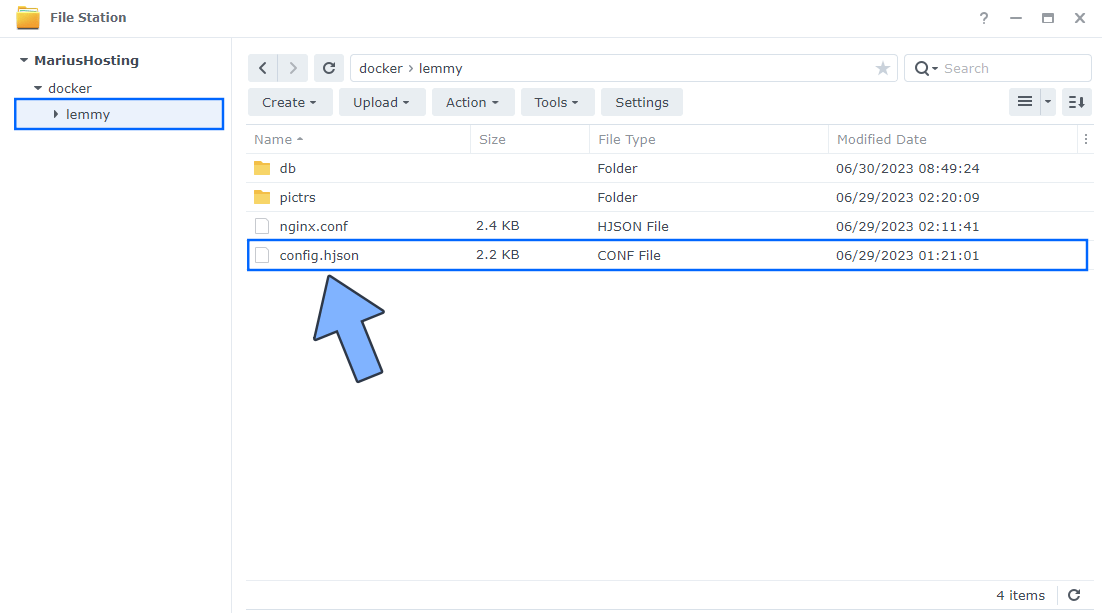
STEP 20
Log into Portainer using your username and password. On the left sidebar in Portainer, click on Home then Live connect. Follow the instructions in the image below.

On the left sidebar in Portainer, click on Stacks then + Add stack. Follow the instructions in the image below.

STEP 21
In the Name field type in lemmy. Follow the instructions in the image below.
services:
db:
image: pgautoupgrade/pgautoupgrade:16-alpine
command:
[
"postgres",
"-c",
"session_preload_libraries=auto_explain",
"-c",
"auto_explain.log_min_duration=5ms",
"-c",
"auto_explain.log_analyze=true",
"-c",
"auto_explain.log_triggers=true",
"-c",
"track_activity_query_size=1048576",
]
container_name: Lemmy-DB
hostname: lemmy-db
security_opt:
- no-new-privileges:true
healthcheck:
test: ["CMD", "pg_isready", "-q", "-d", "lemmy", "-U", "lemmyuser"]
timeout: 45s
interval: 10s
retries: 10
volumes:
- /volume1/docker/lemmy/db:/var/lib/postgresql/data:rw
environment:
POSTGRES_DB: lemmy
POSTGRES_USER: lemmyuser
POSTGRES_PASSWORD: lemmypass
restart: on-failure:5
pictrs:
image: asonix/pictrs:0.5.17-pre.9
container_name: Lemmy-PICTRS
hostname: lemmy-pictrs
security_opt:
- no-new-privileges:true
user: 1026:100
healthcheck:
test: stat /etc/passwd || exit 1
volumes:
- /volume1/docker/lemmy/pictrs:/mnt:rw
environment:
PICTRS_OPENTELEMETRY_URL: http://otel:4137
RUST_LOG: debug
RUST_BACKTRACE: full
PICTRS__MEDIA__VIDEO_CODEC: vp9
PICTRS__MEDIA__GIF__MAX_WIDTH: 256
PICTRS__MEDIA__GIF__MAX_HEIGHT: 256
PICTRS__MEDIA__GIF__MAX_AREA: 65536
PICTRS__MEDIA__GIF__MAX_FRAME_COUNT: 400
restart: on-failure:5
lemmy-back:
image: dessalines/lemmy:0.19.12
container_name: Lemmy-BACK
hostname: lemmy-back
security_opt:
- no-new-privileges:true
user: 1026:100
volumes:
- /volume1/docker/lemmy/config.hjson:/config/config.hjson:ro
environment:
RUST_LOG: "warn,lemmy_server=debug,lemmy_api=debug,lemmy_api_common=debug,lemmy_api_crud=debug,lemmy_apub=debug,lemmy_db_schema=debug,lemmy_db_views=debug,lemmy_db_views_actor=debug,lemmy_db_views_moderator=debug,lemmy_routes=debug,lemmy_utils=debug,lemmy_websocket=debug"
RUST_BACKTRACE: full
restart: on-failure:5
depends_on:
pictrs:
condition: service_healthy
db:
condition: service_healthy
lemmy-front:
image: dessalines/lemmy-ui:0.19.12
container_name: Lemmy-FRONT
hostname: lemmy-front
security_opt:
- no-new-privileges:true
read_only: false
user: 1026:100
healthcheck:
test: wget --no-verbose --tries=1 --spider http://localhost:1234
environment:
LEMMY_UI_LEMMY_INTERNAL_HOST: lemmy-back:8536
LEMMY_UI_LEMMY_EXTERNAL_HOST: lemmy.yourname.synology.me
LEMMY_HTTPS: true #true
restart: on-failure:5
depends_on:
lemmy-back:
condition: service_started
proxy:
image: nginx:1-alpine
container_name: Lemmy-NGINX
hostname: lemmy-nginx
security_opt:
- no-new-privileges:true
healthcheck:
test: curl -f http://localhost:1236/ || exit 1
ports:
- 1236:1236
- 8536:8536
volumes:
- /volume1/docker/lemmy/nginx.conf:/etc/nginx/nginx.conf:ro
restart: on-failure:5
depends_on:
pictrs:
condition: service_healthy
lemmy-front:
condition: service_healthy
Note: Before you paste the code above in the Web editor area below, change the value numbers for user with your own UID and GID values. (Follow my step by step guide on how to do this.) 1026 is my personal UID value and 100 is my personal GID value. You have to type in your own values.
Note: Before you paste the code above in the Web editor area below, change the value for LEMMY_UI_LEMMY_EXTERNAL_HOST and type in your own synology.me DDNS without https:// at the beginning that you have previously created at STEP 12.
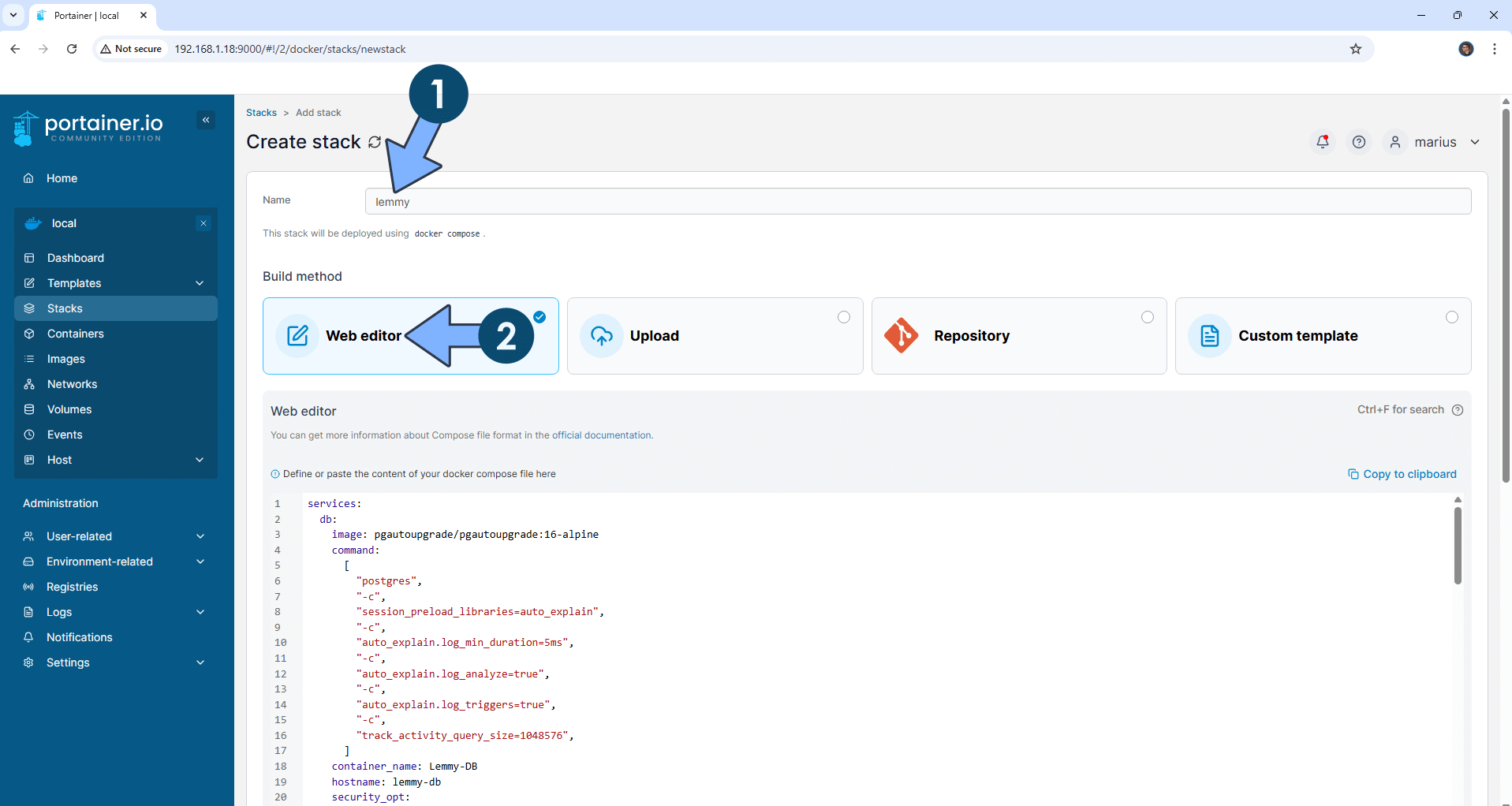
STEP 22
Scroll down on the page until you see a button named Deploy the stack. Click on it. Follow the instructions in the image below. The installation process can take up to a few minutes. It will depend on your Internet speed connection.
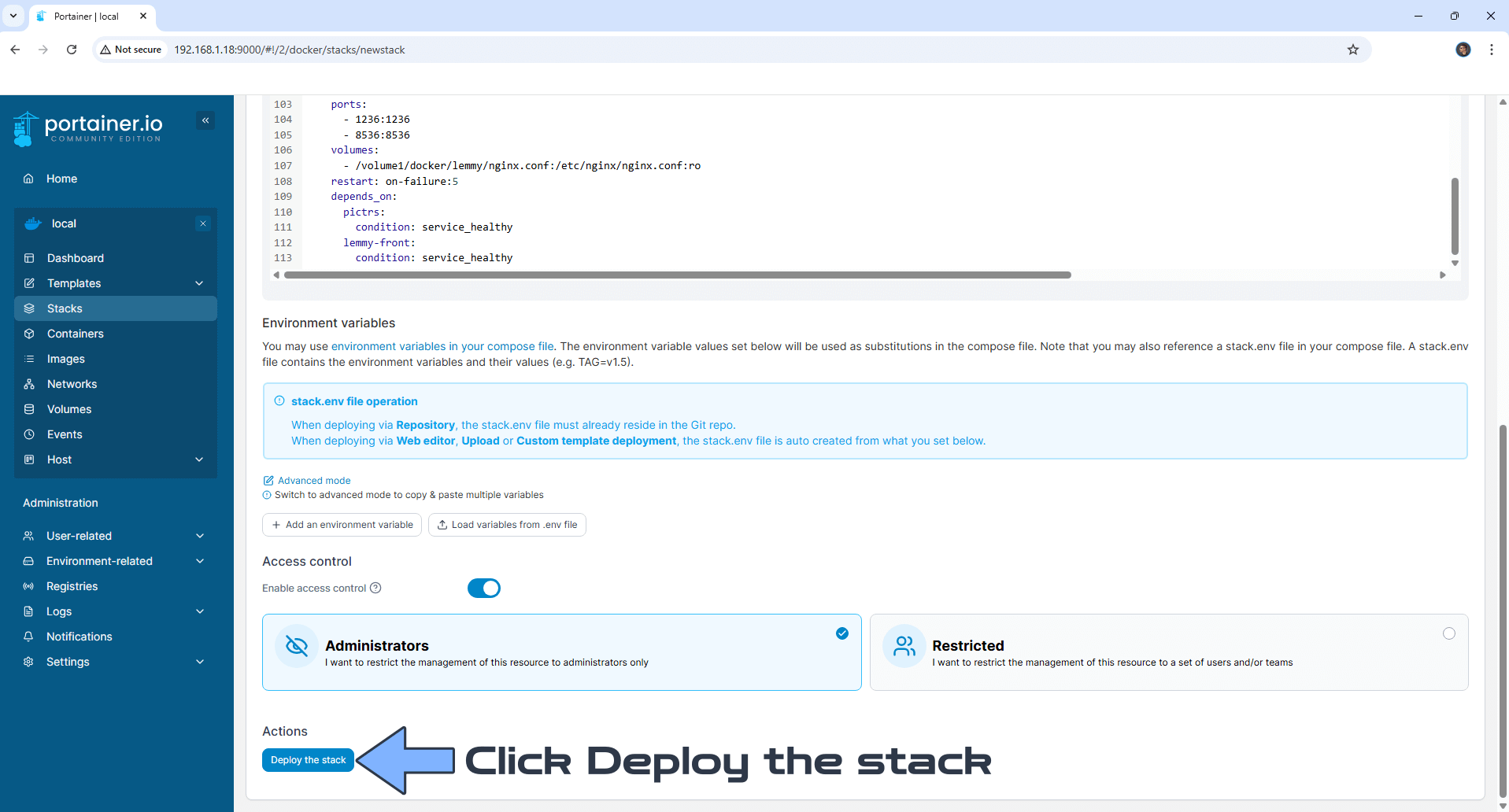
STEP 23
If everything goes right, you will see this message at the top right of your screen: “Success Stack successfully deployed“.

STEP 24
🟢Please Support My work by Making a Donation. Almost 99,9% of the people that install something using my guides forget to support my work, or just ignore STEP 1. I’ve been very honest about this aspect of my work since the beginning: I don’t run any ADS, I don’t require subscriptions, paid or otherwise, I don’t collect IPs, emails, and I don’t have any referral links from Amazon or other merchants. I also don’t have any POP-UPs or COOKIES. I have repeatedly been told over the years how much I have contributed to the community. It’s something I love doing and have been honest about my passion since the beginning. But I also Need The Community to Support me Back to be able to continue doing this work.
STEP 25
Now open your browser and type in your HTTPS/SSL certificate like this https://lemmy.yourname.synology.me that you have previously created at STEP 12. In my case it’s https://lemmy.mariushosting.synology.me If everything goes right, you will see the Lemmy Login page. At the top right of the page click Login. Follow the instructions in the image below.
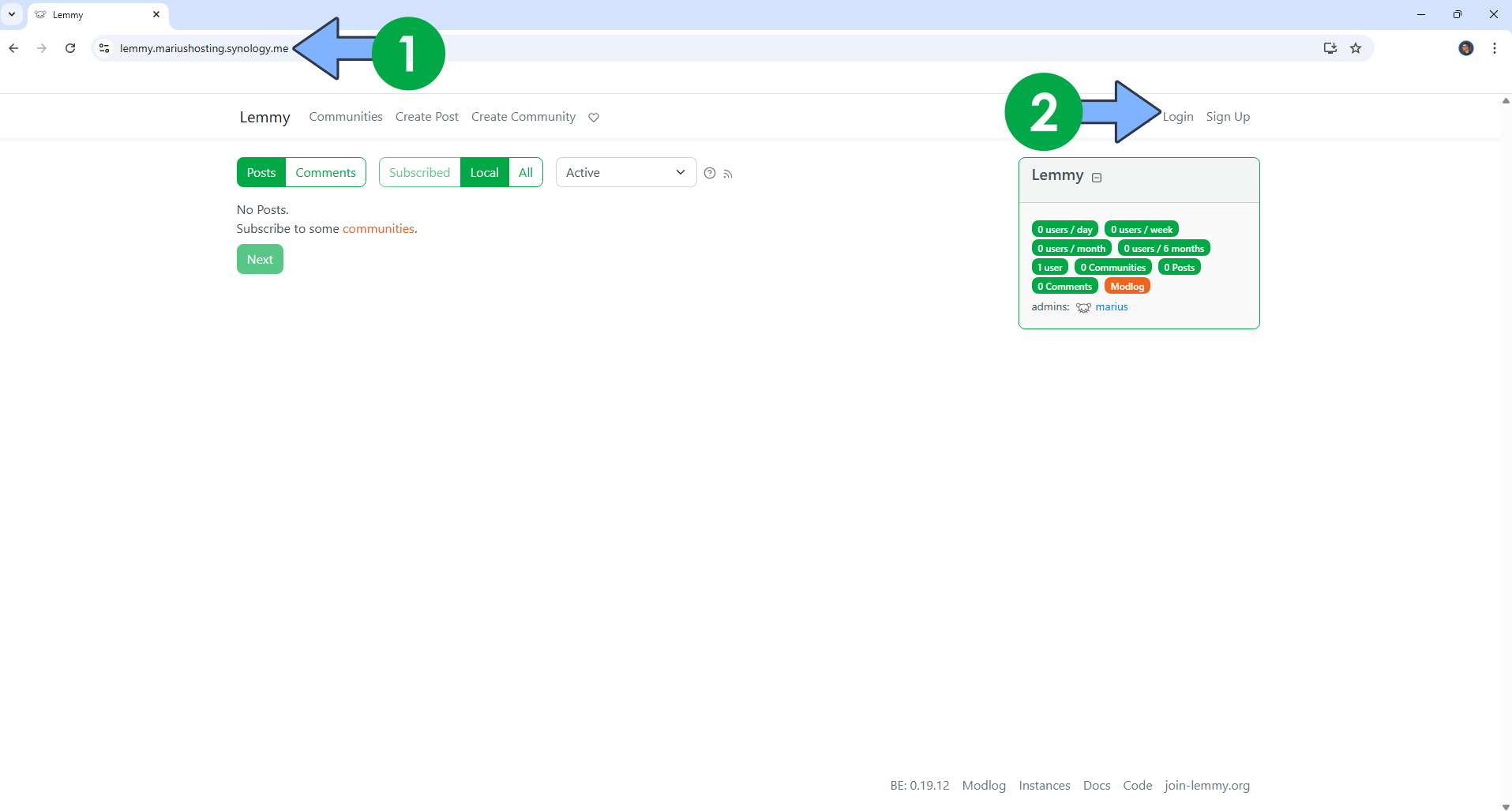
STEP 26
Type in your own Email Address and Password that you have previously created in your own config.hjson file at STEP 18. Click Login. Follow the instructions in the image below.
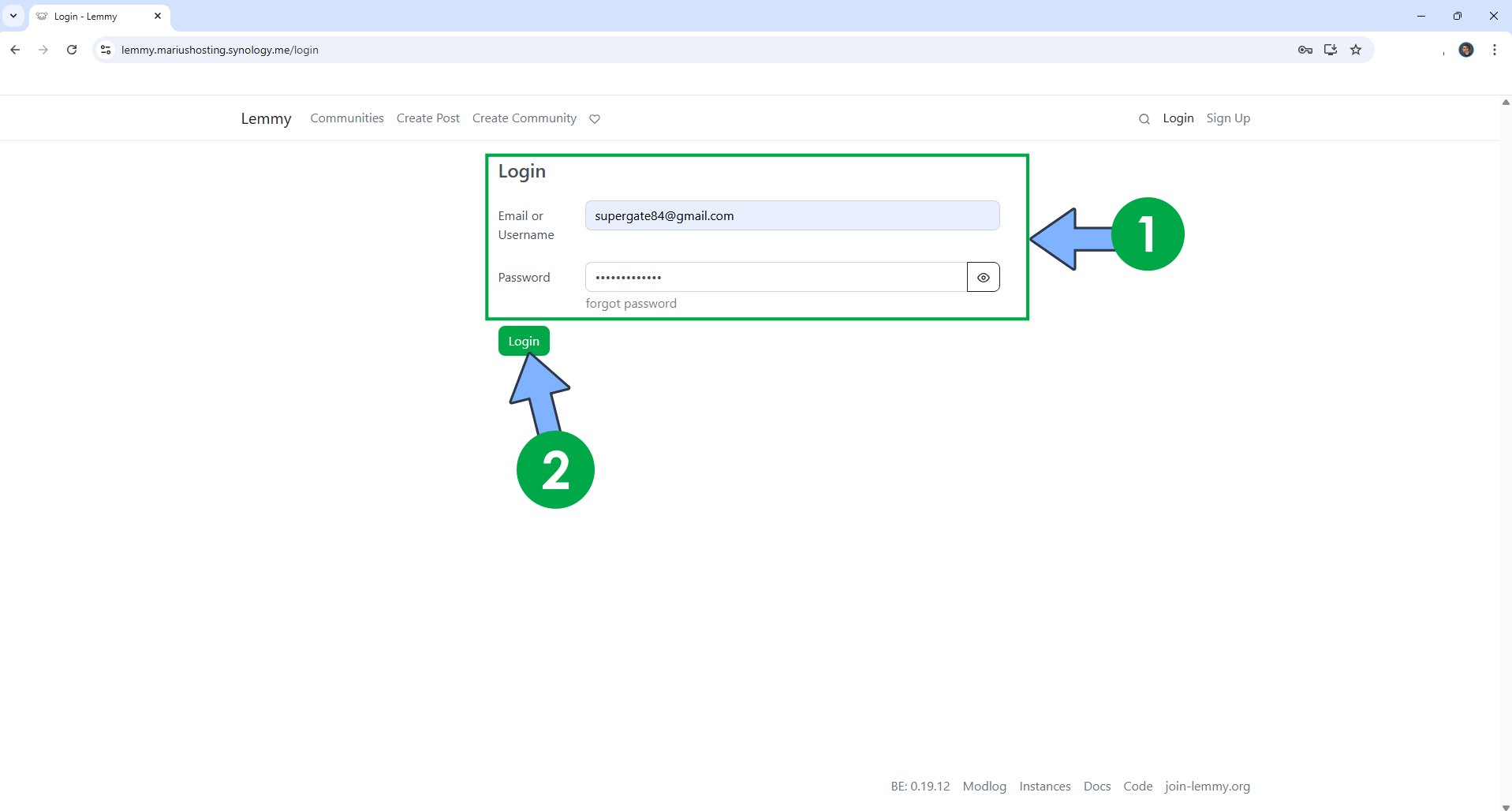
STEP 27
At the top right of the page click on your name then Settings. Change your settings like the email, avatar, banner, display name, languages and password. Scroll down the page a little bit. Follow the instructions in the image below.
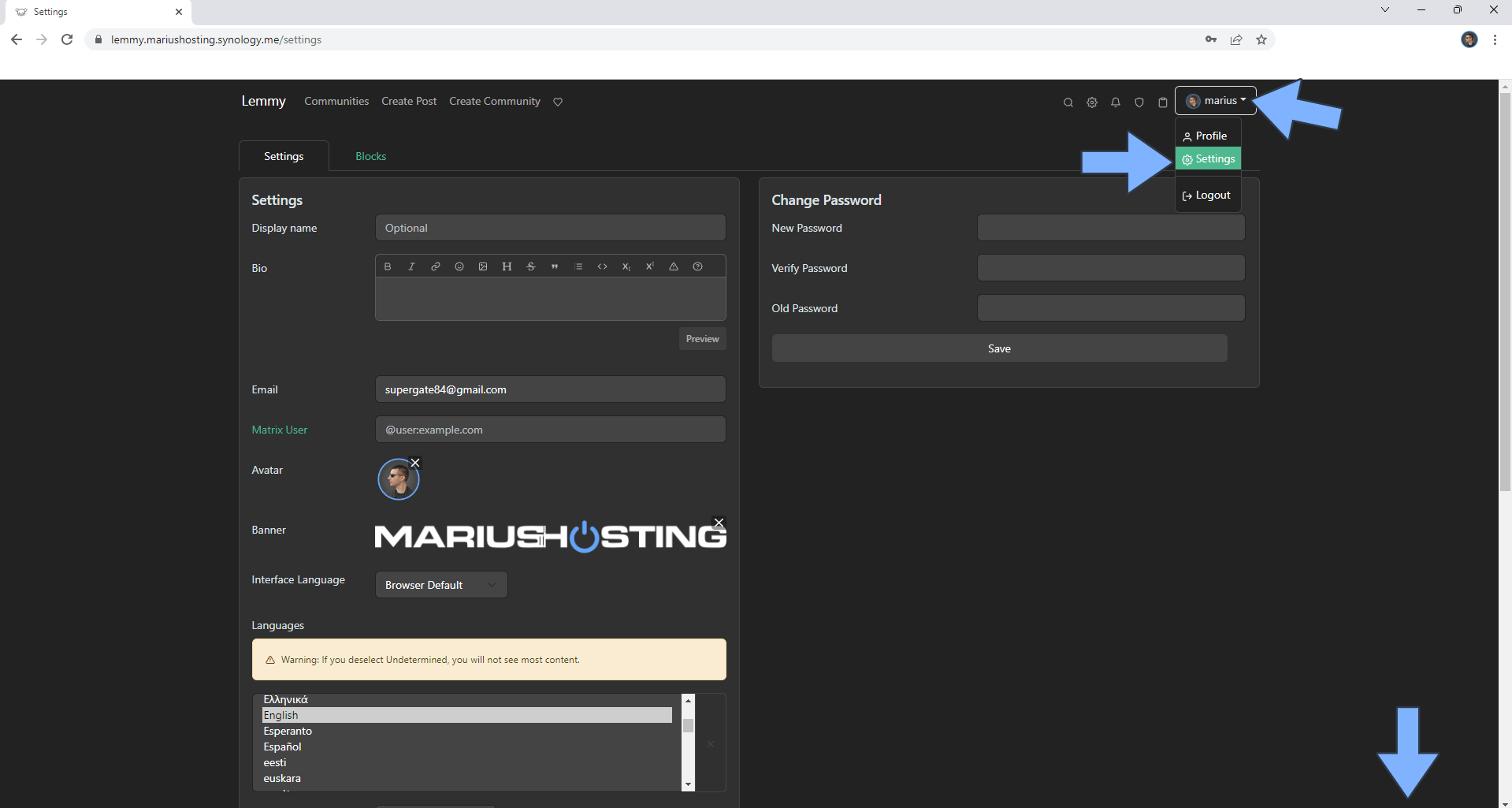
STEP 28
Choose your favorite Theme, then click Save to save the settings. Follow the instructions in the image below.
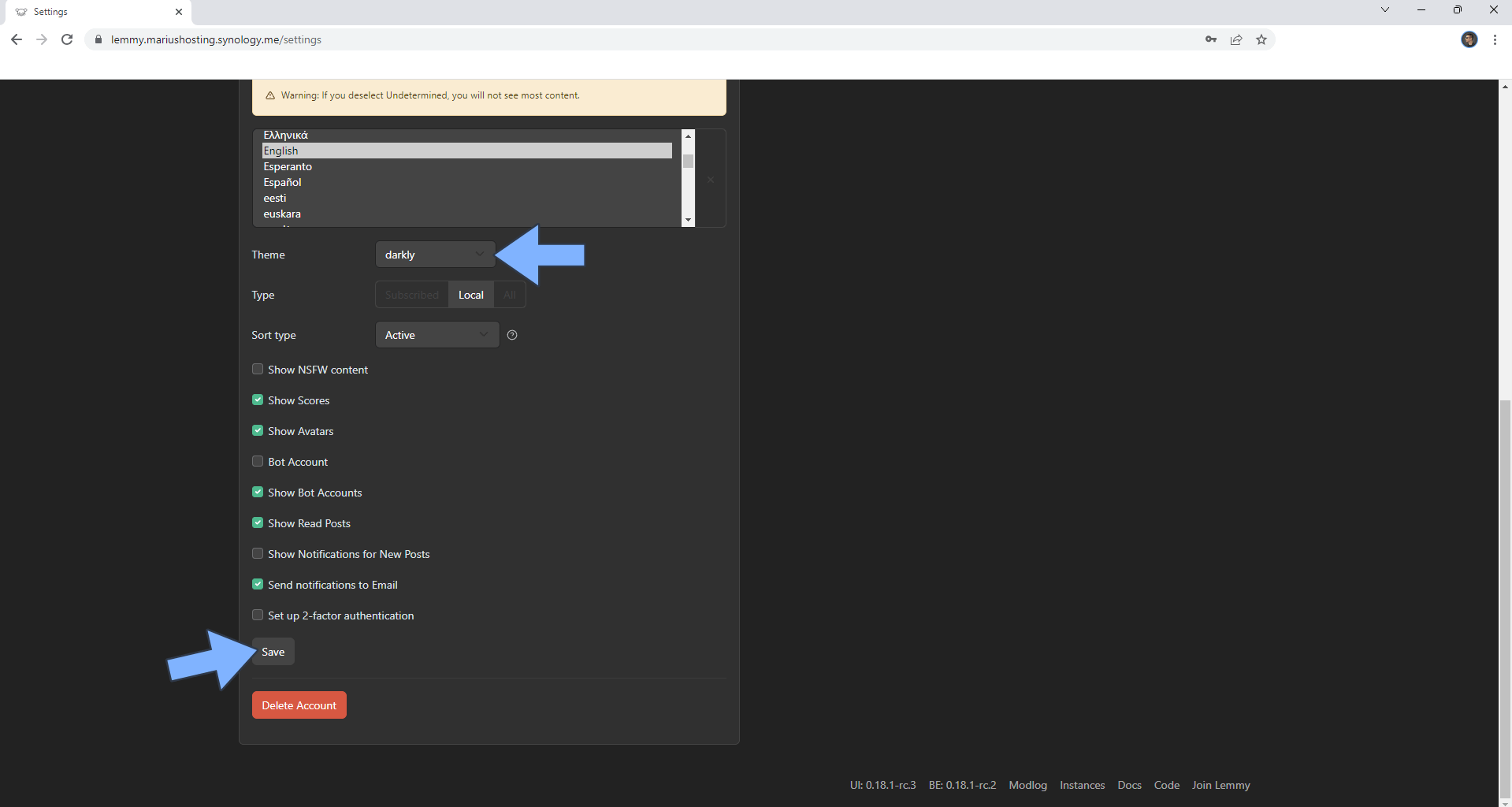
STEP 29
Click Create Community to create your first community on your own Lemmy server.
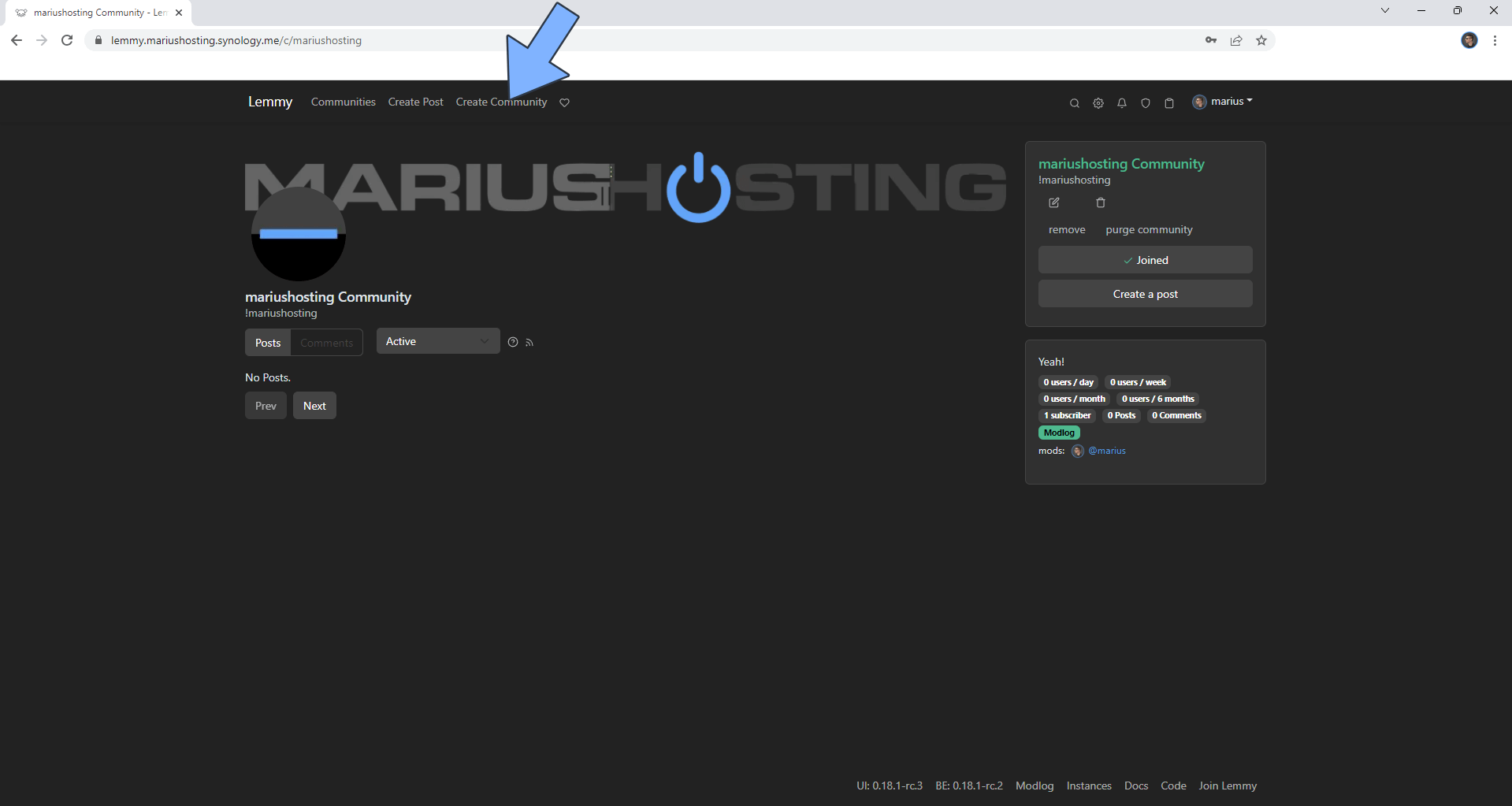
STEP 30
If someone wishes to sign up to your server, they must click the Sign Up button at the top right of the page, then add their details and click Sign Up. Follow the instructions in the image below.

STEP 31
Once a new user registers to your server, you, as an administrator, will see a little notification at the top right of the page. Click on it. Follow the instructions in the image below.

STEP 32
You need to manually Approve the new user by clicking the Approve button. Follow the instructions in the image below.
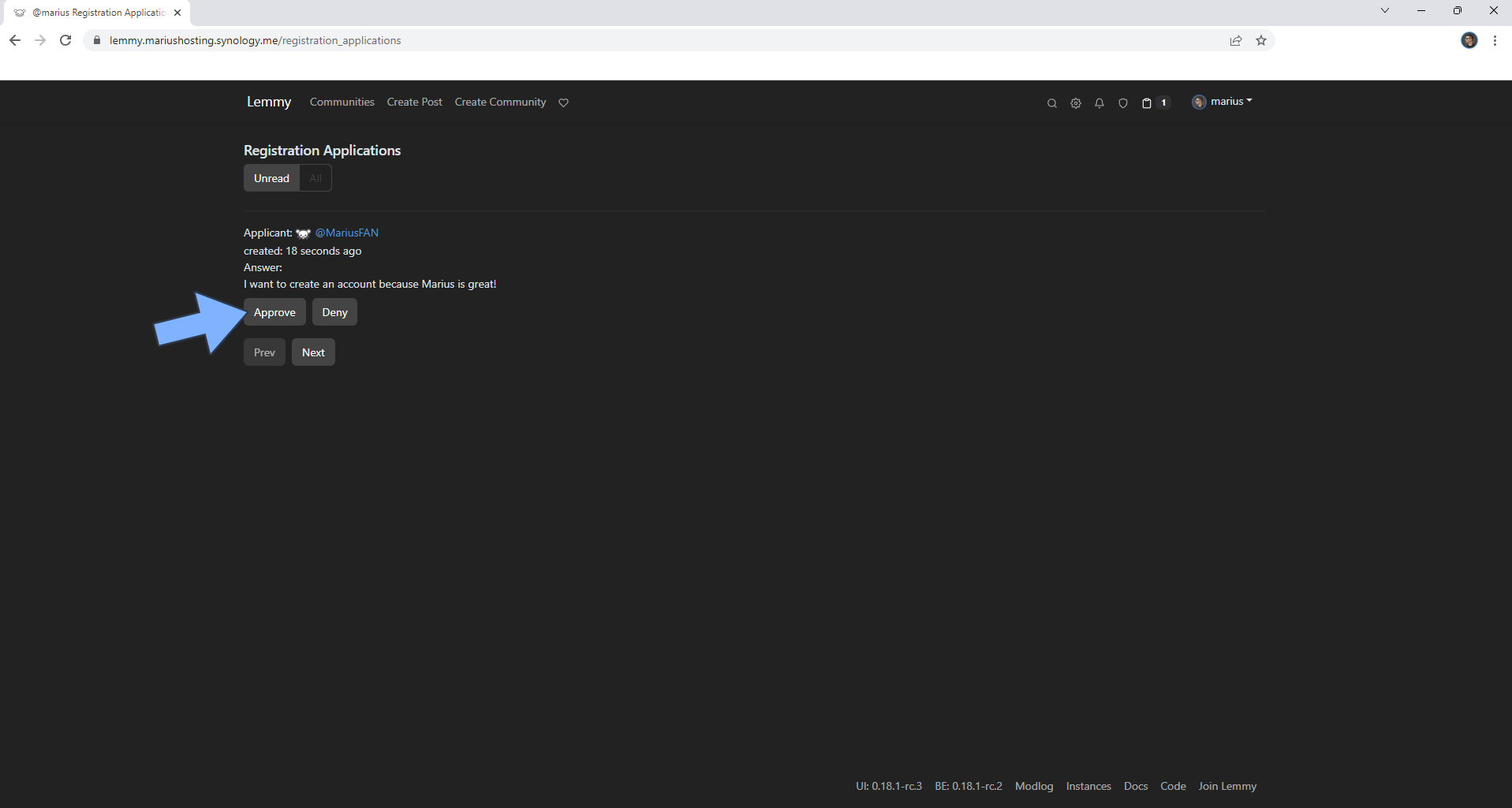
STEP 33
Once a user is registered, they automatically receive a message via email that says their registration application has been approved, on the condition that you, as an administrator, have clicked the Approve button as per the instructions at STEP 32.

Enjoy Lemmy!
If you encounter issues by using this container, make sure to check out the Common Docker issues article.
Note: Can I run Docker on my Synology NAS? See the supported models.
Note: How to Back Up Docker Containers on your Synology NAS.
Note: Find out how to update the Lemmy container with the latest image.
Note: How to Free Disk Space on Your NAS if You Run Docker.
Note: How to Schedule Start & Stop For Docker Containers.
Note: How to Activate Email Notifications.
Note: How to Add Access Control Profile on Your NAS.
Note: How to Change Docker Containers Restart Policy.
Note: How to Use Docker Containers With VPN.
Note: Convert Docker Run Into Docker Compose.
Note: How to Clean Docker.
Note: How to Clean Docker Automatically.
Note: Best Practices When Using Docker and DDNS.
Note: Some Docker Containers Need WebSocket.
Note: Find out the Best NAS Models For Docker.
Note: Activate Gmail SMTP For Docker Containers.
This post was updated on Friday / October 3rd, 2025 at 8:19 AM
